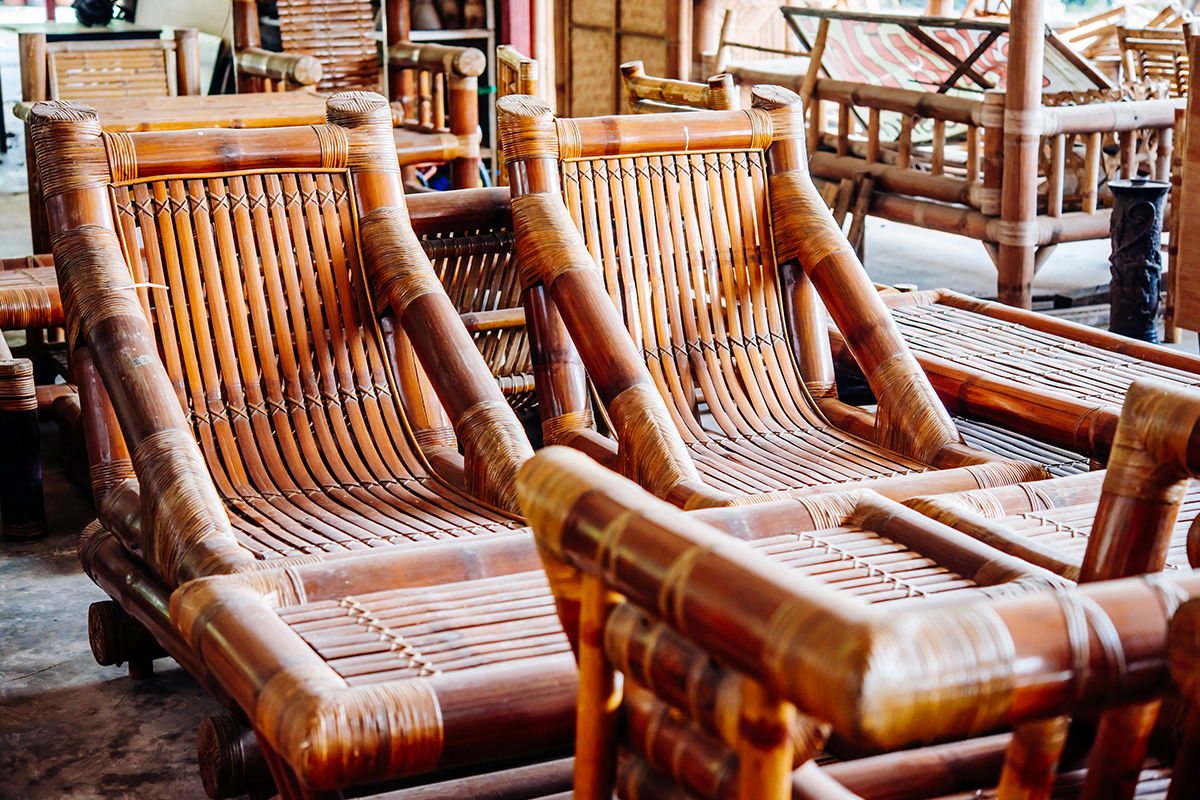Bamboo is the fastest-growing plant on the planet. It has been recorded to grow an incredible 47.6 inches (120 cm) in 24 hours. It is a highly versatile and sustainable plant offering numerous benefits. In this article, we will focus on the many environmental benefits of this impressive tree-like plant.
.png?width=1200&height=800&name=Corekees_%20What%20kind%20of%20nature%20benefits%20does%20bamboo%20offer__visual%201(2).png) Forest of tall bamboo trees.
Forest of tall bamboo trees.
Carbon sequestration
Bamboo absorbs large amounts of carbon dioxide (CO2) from the atmosphere. In a span of only seven years, newly planted bamboo sequesters up to 2 tonnes of CO2. Compared to pine, bamboo can absorb up to five times more CO2. While every type of tree has a unique role in the ecosystem, bamboo trees have a high potential to counteract large amounts of CO2 efficiently. In addition, bamboo absorbs pollutants from the air, helping to improve air quality.
Soil erosion prevention
Bamboo has rhizomes which are underground stems that grow horizontally and can give rise to new shoots and roots. Rhizomes store the plant's food and nutrients and help it survive adverse conditions, such as drought or fire.
Due to its fast growth, permanent canopy, and extensive network of roots and rhizomes, bamboo is an excellent tool for preventing erosion and protecting water quality.
Its surface layer root system extends 20 to 60 cm deep and can cover up to 100 km. Moreover, bamboo regenerates even if the stems are cut or destroyed in a fire or storm. This is due to its rhizomes’ long life, which can survive for over a century. The rhizomes are particularly useful for stabilising slopes, riverbanks, degraded land, and areas prone to landslides, as they help to bind topsoil and prevent erosion.
Learn more: The first bamboo project by Corekees
Biodiversity and natural habitats
Bamboo forests support a high level of biodiversity, with many species of plants, animals, and microorganisms living within them. Bamboo forests provide vital habitats, food, and shelter for various species.
For example, the giant panda subsists on a diet composed of bamboo shoots and leaves, accounting for over 99% of their food intake. According to the International Union for Conservation of Nature (IUCN), it is considered a vulnerable species. The wild population is estimated to be between 1,600 and 2,500.
Other species that depend on bamboo for food and/or shelter include red pandas, bamboo bats, mountain gorillas, sun bears, Madagascar lemurs, tapirs, panthers, and more. Unfortunately, some of those species are threatened and in need of more habitats.
.png?width=1200&height=800&name=Corekees_%20What%20kind%20of%20nature%20benefits%20does%20bamboo%20offer__visual%201(1).png) A giant panda eats a large bamboo stalk.
A giant panda eats a large bamboo stalk.
Read more: Impact of forests on biodiversity
Water conservation
Bamboo is a versatile and effective tool for water conservation efforts. It is increasingly used by environmental organisations and governments worldwide to help protect and conserve our precious water resources.
Bamboo plants have a low water requirement and can grow in areas with limited water resources, helping to conserve water. They are often used in water conservation efforts because they have a deep and extensive root system that can prevent soil erosion and stabilise riverbanks. When planted along riverbanks or other bodies of water, bamboo roots can hold the soil in place, preventing it from being washed away during heavy rainfall or flooding.
Bamboo also can absorb large amounts of water, making it an effective tool for reducing runoff that enters nearby waterways. This can help prevent soil erosion and reduce the risk of flooding downstream.
In addition, bamboo can be used to create natural barriers or dams, slowing the flow of water and allowing it to be absorbed into the surrounding soil. This can increase the amount of water available to nearby plants and trees, helping to improve the health of local ecosystems.
Renewable resource
Bamboo is a highly renewable resource that can be harvested sustainably without damaging the environment. It is an environmentally friendly alternative to traditional building materials such as wood and concrete.
Bamboo also has a higher yield per acre than other crops, meaning it can produce more usable material in the same amount of space. Additionally, bamboo requires very little water, pesticides, or fertilisers to grow, making it a more sustainable option for agriculture.
Furthermore, bamboo is versatile and can be used for a wide range of products, including flooring, furniture, paper, textiles, and even as a food source for animals and humans.
Therefore, using bamboo as a renewable resource has gained popularity in recent years as an alternative to traditional materials with a higher environmental impact.
 Bamboo workshop where bamboo furniture is made.
Bamboo workshop where bamboo furniture is made.
Read more: Exploring the many uses of bamboo in our daily lives
Plant more bamboo with Corekees’ Project Bamboo
With these significant benefits, bamboo deserves more attention and support. Corekees, operating under the umbrella of DGB Group, started its first campaign to plant bamboo in Europe in partnership with Bamboologic.
This project is called Project Bamboo. It provides carbon credits certified by the ONCRA, a Dutch open-source accounting framework for CO2 removal. The credits are granted based on transparent measurements, and the corresponding data is easily accessible. These carbon credits serve as transition financing, incentivising companies that invest in nature to continue their efforts.
Learn more about Project Bamboo

.png?width=1200&height=800&name=Corekees_%20What%20kind%20of%20nature%20benefits%20does%20bamboo%20offer__visual%201(2).png)
.png?width=1200&height=800&name=Corekees_%20What%20kind%20of%20nature%20benefits%20does%20bamboo%20offer__visual%201(1).png)


